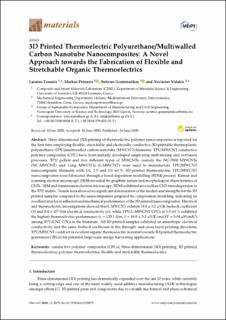| dc.contributor.author | Tzounis, Lazaros | |
| dc.contributor.author | Petousis, Markos | |
| dc.contributor.author | Grammatikos, Sotirios | |
| dc.contributor.author | Vidakis, Nectarios | |
| dc.date.accessioned | 2022-05-10T08:46:12Z | |
| dc.date.available | 2022-05-10T08:46:12Z | |
| dc.date.created | 2020-07-25T11:51:03Z | |
| dc.date.issued | 2020 | |
| dc.identifier.citation | Materials. 2020, 13 (12), . | en_US |
| dc.identifier.issn | 1996-1944 | |
| dc.identifier.uri | https://hdl.handle.net/11250/2994982 | |
| dc.description.abstract | Three-dimensional (3D) printing of thermoelectric polymer nanocomposites is reported for the first time employing flexible, stretchable and electrically conductive 3D printable thermoplastic polyurethane (TPU)/multiwalled carbon nanotube (MWCNT) filaments. TPU/MWCNT conductive polymer composites (CPC) have been initially developed employing melt-mixing and extrusion processes. TPU pellets and two different types of MWCNTs, namely the NC-7000 MWCNTs (NC-MWCNT) and Long MWCNTs (L-MWCNT) were used to manufacture TPU/MWCNT nanocomposite filaments with 1.0, 2.5 and 5.0 wt.%. 3D printed thermoelectric TPU/MWCNT nanocomposites were fabricated through a fused deposition modelling (FDM) process. Raman and scanning electron microscopy (SEM) revealed the graphitic nature and morphological characteristics of CNTs. SEM and transmission electron microscopy (TEM) exhibited an excellent CNT nanodispersion in the TPU matrix. Tensile tests showed no significant deterioration of the moduli and strengths for the 3D printed samples compared to the nanocomposites prepared by compression moulding, indicating an excellent interlayer adhesion and mechanical performance of the 3D printed nanocomposites. Electrical and thermoelectric investigations showed that L-MWCNT exhibits 19.8 ± 0.2 µV/K Seebeck coefficient (S) and 8.4 × 103 S/m electrical conductivity (σ), while TPU/L-MWCNT CPCs at 5.0 wt.% exhibited the highest thermoelectric performance (σ = 133.1 S/m, S = 19.8 ± 0.2 µV/K and PF = 0.04 μW/mK2) among TPU/CNT CPCs in the literature. All 3D printed samples exhibited an anisotropic electrical conductivity and the same Seebeck coefficient in the through- and cross-layer printing directions. TPU/MWCNT could act as excellent organic thermoelectric material towards 3D printed thermoelectric generators (TEGs) for potential large-scale energy harvesting applications. | en_US |
| dc.language.iso | eng | en_US |
| dc.publisher | MDPI | en_US |
| dc.rights | Navngivelse 4.0 Internasjonal | * |
| dc.rights.uri | http://creativecommons.org/licenses/by/4.0/deed.no | * |
| dc.title | 3D printed thermoelectric polyurethane/multiwalled carbon nanotube nanocomposites: A novel approach towards the fabrication of flexible and stretchable organic thermoelectrics | en_US |
| dc.title.alternative | 3D printed thermoelectric polyurethane/multiwalled carbon nanotube nanocomposites: A novel approach towards the fabrication of flexible and stretchable organic thermoelectrics | en_US |
| dc.type | Peer reviewed | en_US |
| dc.type | Journal article | en_US |
| dc.description.version | publishedVersion | en_US |
| dc.source.pagenumber | 16 | en_US |
| dc.source.volume | 13 | en_US |
| dc.source.journal | Materials | en_US |
| dc.source.issue | 12 | en_US |
| dc.identifier.doi | 10.3390/ma13122879 | |
| dc.identifier.cristin | 1820487 | |
| cristin.ispublished | true | |
| cristin.fulltext | original | |
| cristin.qualitycode | 1 | |

